Green New Deal Simulator: Challenge Climate Change
We will be investigating the Green New Deal Simulator to understand its educational components and how Molleindustria makes hard to digest information fun.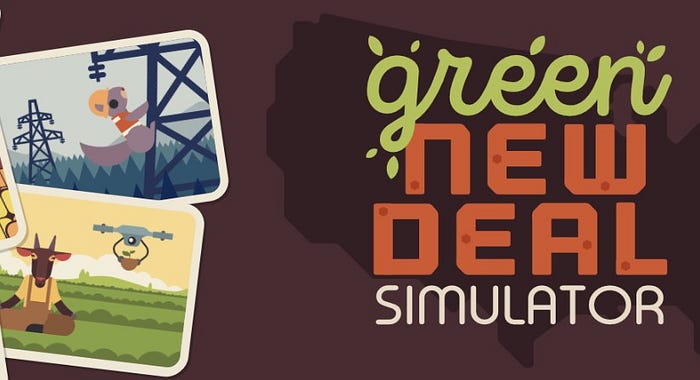
What is The Green New Deal Simulator?
The Green New Deal Simulator is a tiny deck-building game that helps the user navigate through the complexity of climate change within the United States. The player is tasked with the main goal of transitioning the United States to a post-carbon economy while ensuring full employment. This has the player drag and drop action cards onto various regions of the USA, evaluate the impact, and expand their deck. However, time is limited and the budget is always running out so the player is always on edge when making decisions.
This game was developed by Molleindustria — “who produce artisanal remedies to the idiocy of mainstream entertainment in the form of short experimental games” (according to their blog). The Green New Deal Simulator is available on multiple platforms: PC, Mac, Android, IOS, and browser.
Play the game here: Green New Deal Simulator
Educational Goals
This game aims to teach players about environmental sciences, climate change, renewable energy, and the challenges that come with trying to create a fully green nation. They do this by having the player make strategic decisions that impact the level of green electricity, fuel electricity, gasoline and natural gas, and employment at every played card.
The game seems to want to make the player more aware about climate change and the steps it would take to transition the United States to a post-carbon economy. The Green New Deal Simulator assumes that the player already has prior knowledge of climate change, how to play a deck-building game with consequences, and how to strategically play a game given constraints.
Since each action card is based on real-world policies and solutions, the information gained from each card can be transferred to real world discussions and helping the player become more aware of the reality our world is living in.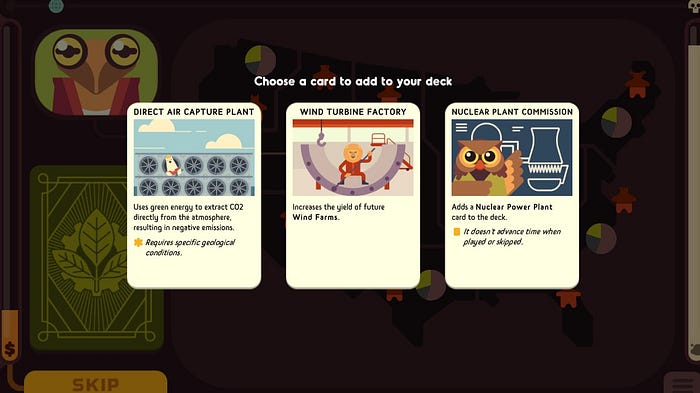
Game Elements
Nouns and Verbs
The game’s main nouns includes:
- The deck of action cards the player can use
- Random event cards that can cause disasters
- The map split into regions
- Each region has a pie chart of green electricity, fuel electricity, gasoline and natural gas
- Each region also has a diagram of its employment rate
- A budget tracker
- An emmissions tracker
- A progress bar towards imminent death
From this, the verbs allow the player the ability to either play, skip, or hold action cards depending on what they want to apply to each region, how it will effect the region and neighboring regions, and how much money they have within their budget.
Gameplay Loop
The gameplay consists of the player picking a card out of the deck and seeing if they can place it on a region to decrease fuel electricity and gasoline and natural gas while increasing green electricity. They can either skip a card to increase their budget or hold the card to play it later in the game. This can be described as one ‘turn’ in the game. As the player progresses, the deck would be reshuffled, the emissions tracker would slowly decrease based on their progress, and the globe icon would slowly crawl towards imminent death.
An interesting inner loop can be seen where the player has the ability to play a research lab card where they can pick a new action card to play. By picking a new card, they have the ability to introduce new factories or programs that can accelerate the progress of introducing green electricity.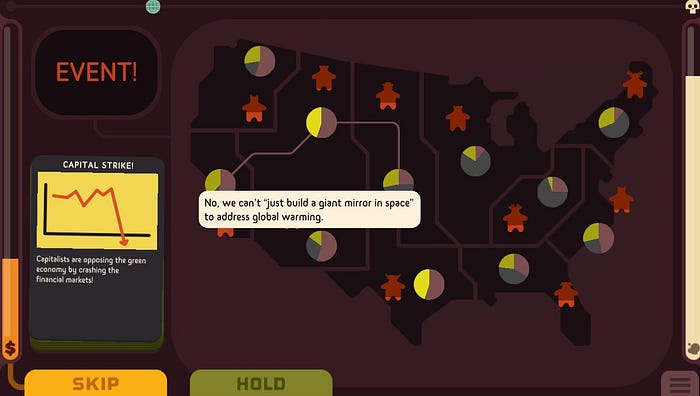 okay capitalists
okay capitalists
Player Experience
When first starting out with the game, there is a learning curve as they would have to know what each card does and how it effects regions alongside other regions. However, the game is pretty good at giving immediate feedback as the pie charts and employment rates change when hovering over a region. This allows the player to quickly check different regions and compare and contrast how a card would effect them.
After playing a few games to understand the mechanics, players should (and hopefully would) form strategies to pick the optimal cards and play them at correct moments such that — towards the end of the game — the player has a successful transition to a post-carbon economy. This can be considered stressful as losing results in submitting to an authoritarian government.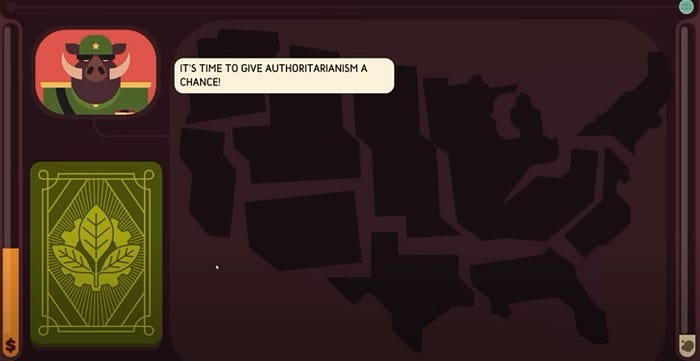 based?
based?
Learning Mechanisms
Amongst the different types of learning mechanisms seen within this game, it is trying to impact the player’s Sense-making/Understanding and Induction/Refinement via spatial contiguity and immediate feedback timing. Although there are multiple other learning mechanisms that can be found, I will only focus on these two for now.
Sense-making through Spatial Contiguity
Besides the text on the cards and the screen that tells the player what each diagram means, theres little to no text on the screen. This means that, when a player forgets what a diagram means, they need to refer to some sort of map key. This is where the top left screen key comes in handy. Descriptive text as well as the diagram visual will pop up in this screen to tell the player what piece of the pie chart is what as well as remind them that a non-filled animal diagram is better than a filled one. The overall learning mechanism of sense-making helps the game move more smoothly and offers them an easier way to play the game.
In addition to this, each card has its respective title, description, and how it can aid the player. This allows the player to understand what each card means and because of its coherence through spatial contiguity, it furthers their understanding of what they can do.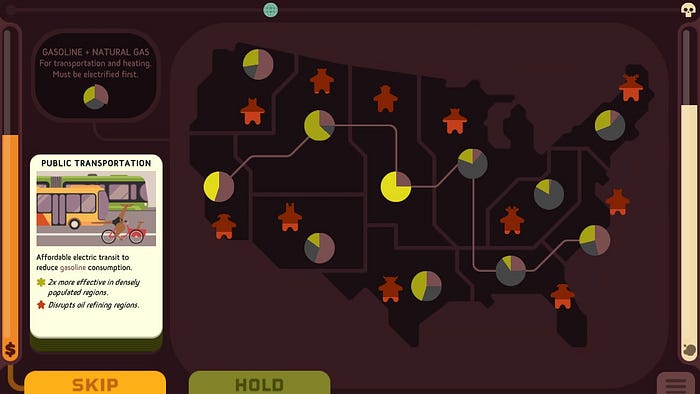 Top left screen gives a description of Gasoline and Natural Gas. The card gives a description of Public Transportation
Top left screen gives a description of Gasoline and Natural Gas. The card gives a description of Public Transportation
Refinement through Immediate Feedback Timing
Furthermore, the player relies on immediate feedback to refine their playstyle. For example, if the player is about to place a card at a region, they can hover that card over other regions to compare and contrast how it will affect those regions / neighboring regions. The player is given instant feedback to let them know whether or not placing it in one region is better than another. The feedback is provided via the diagrams on each region changing dynamically as they move the card around. However, once a card is placed, the player can no longer pick that card back up.
Although placing a card down or comparing how it does at different regions does not count as “errors,” players can use this type of immediate feedback timing to strategically think about their next moves on which region they would want to priortize. This aids the player’s strategic refinement as the instant feedback allows them to rethink their next moves and potentially, their next game.
Final Thoughts
I found that this game is successful as both a game and a learning experience. As I played the game, I found myself reading the titles and descriptions of each card and learned more and more about the different solutions that are proposed within the Green New Deal. I also put my brain to the test when coming up with different strategies on how to play the game and which cards were better compared to others. In the end, I did end up winning the simulator; but as stated in the game, the real world will not run as smoothly as it did within the game. There is so much more complexity built into our reality.
On a more personal note, I enjoyed a lot of other games made by Molleindustria. Molleindustria, also known as Paolo Pedercini, is a professor here at Carnegie Mellon University and has made many games to educate the general population about current events and politics. I highly recommend checking out the other games on hiswebsite here: Molleindustria.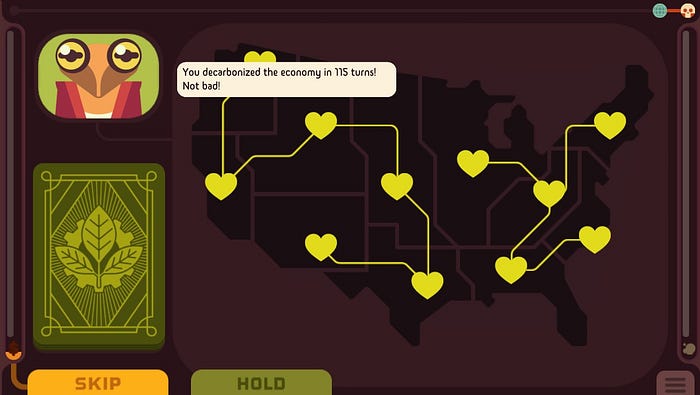 I tried my best!
I tried my best!


























































